|
Monday, May 9, 2011
Progress Notes
In any of the photos you may have seen of the old courthouse in Tuscumbia taken from the south side, you may have noticed a white frame building several feet down the hill located on the south side of the street facing the courthouse. Here is an old photo taken in 1895 which reveals this building (photo 01).
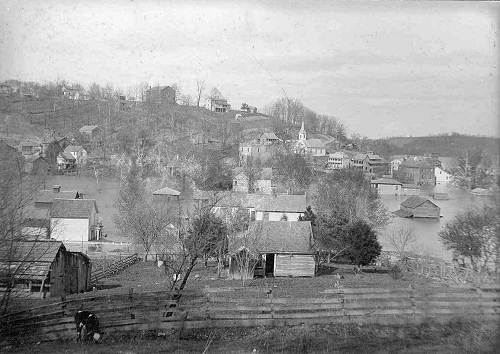
01 1895 Flood looking up to Brick Courthouse
Click image for larger view
Close up of the white frame building (photo 01a):
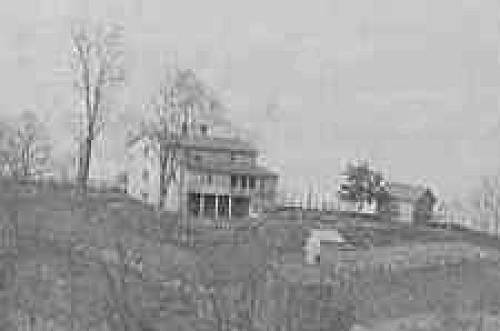
01a White Framed House
The building was one of the older ones constructed on top of the hill as you might deduce from recognizing that the courthouse itself is the old 1858 one built before the reconstructed one of 1910, the one standing vacant now (photo 02).

02 Old Courthouse- Built 1910
The present courthouse, built about six years ago, is located on Highway 52 on the north side of town.
The white frame building was taken down in 1963 to be replaced by the white stucco building now present used by the County Extension office.
The history of the old house was presented in an Autogram article in January of 1963:
Miller County Autogram Sentinel
January 1963
A Tuscumbia landmark, an eight room building south of the courthouse, long unused, and an eyesore to the county property, is being razed to make way for the erection of a new office building on the site. The Midway Salvage Company is in charge of the salvage operation and is clearing the site as quickly as possible (photo 03).

03 Old Hotel
Click image for larger view
Miller County acquired the property, including the five lots upon which it is situated in January, 1940, from Mrs. Belle Fancher, for the sum of $1,200 (photo 04).

04 Belle Fancher with grandson Ralph Hendley
The county had rented the building at $20 per month from Mrs. Fancher for a year previous to its purchase to house the Social Security office. Court records state that it was purchased in order to provide an addition to and an enlargement of the present courthouse site.
The Autogram of that date stated that the ever increasing number of governmental agencies had crowded the courthouse and made additional housing space necessary. The building was used as a welfare office and distribution center for relief commodities.
During World War II, the rationing office was located there part of the time.
The building, one of Tuscumbia’s oldest, for many years had a flow of traffic through its rooms from many who helped formulate the history of the town and county.
Its history goes back to I.M. Goodrich who owned the property from 1865 until 1897 when he sold it to Stuart Baysinger (photo 05).
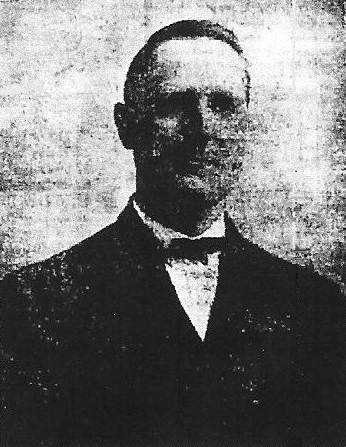
05 Dr. Stuart Lee Baysinger
Goodrich, a large land holder of that day, also Miller County circuit clerk and recorder in 1863-1867, played a large part in the early development of Tuscumbia. A Goodrich addition was laid out, and residences built, as was the well known Goodrich home, now a part of the Humphreys Hospital facilities. The poultry farm there was said to have not only included the usual domesticated poultry varieties, but the more unusual and glamorous pea fowls, Chinese pheasants, quail, and a variety of geese.
Another Goodrich farm near Tuscumbia, now the Fred Pryor farm, specialized in fine horses and boasted a race track. A couple of carloads of western horses were also once brought there, it is said.
Note: You can read more about the extensive number of properties owned around Tuscumbia by the Goodrich family at the previous Progress Notes of February 1, 2010.
It was the Baysinger family, however, who did extensive remodeling and made the home into one of Tuscumbia’s nicest large homes of the day.
Other owners were Barney Reed, Willard Spearman, Hugh Atwell, Louis Edwards, Ira Harbison, and Mr. and Mrs. Frank Harbison.
The house was frequently used as a hotel for the many overnight guests whose business at the courthouse kept them in town for several days, by traveling salesmen (drummers) and others. During the construction of the Osage bridge and when Highways 52 and 17 were being built, workers also boarded there. Family style meals were served for the public by several of its occupants.
Most of the owners were county office holders at one time or another: Barney Reed, prosecuting attorney; Willard Spearman, county clerk; Hugh Atwell, county superintendent of schools and prosecuting attorney; Louis Edwards, probate judge; and Ira Harbison, county treasurer.
Mr. and Mrs. Frank Harbison were visited by both birth and death during their ownership, with the death of their only daughter, Clara Pauline, only a week after the birth of their youngest son, Rex.
Tentative plans for the new office building are being made by the court. Royal Kallenbach has been appointed as building superintendent. He has been sworn in and bonded and will begin his duties about February 1.
The new office building will provide a centralized location for numerous departments and relieve some of the over crowded offices presently located in the courthouse.
Bell Williams Fancher, the last owner of the old hotel, was the husband of Charles Fancher of Iberia who had passed away in 1933, several years before Belle sold the old hotel in 1940. Charles was an important figure in the history of Iberia about whom you can read more on our website written by Peggy Hake.
Belle and Charles had one surviving child named Eleanor, who married James Hendley of Tuscumbia (photo 06).

06 James and Eleanor Fancher Hendley Wedding Photo - 1933
James’ father was Charles Sanford Hendley, a minister, who came to Miller County from Kentucky but later moved to Michigan before returning to Miller County where he passed away (photo 07).
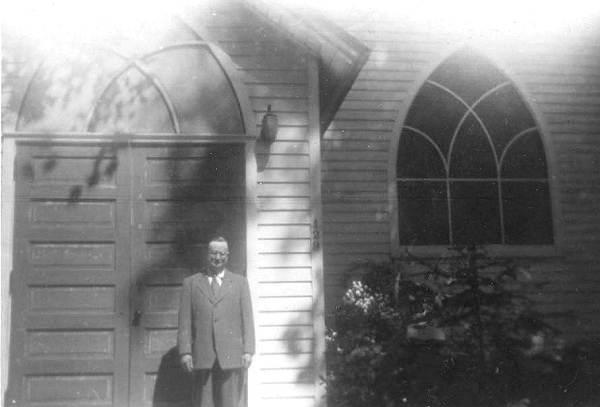
07 Charles Sanford Hendley 1880-1970
James and Eleanor Hendley, after marrying, moved to a farm on Rush Road off Highway 17 not far from Tuscumbia. There James and Eleanor had their first child, Ralph Hendley. Ralph often would visit his grandmother at the old hotel before she sold it (see photo 04 above of Belle and Ralph). After Belle sold the old hotel building, she lived with James and Eleanor on the Rush Road farm. Not long after she moved there, she became ill with heart failure. About that time James had bought a farm on Highway 17 ten miles south of Tuscumbia and was making plans to move as soon as he improved the existing home there. However, Belle told him she wanted to move right away as she didn’t feel she was going to live long. So James hurried his plans moving that week and just as Belle feared, she died seventeen days later of “dropsy,” an old term for heart failure which is associated with edema and swelling of the feet and ankles.
James and Eleanor also had a second child named Catherine (photo 08).
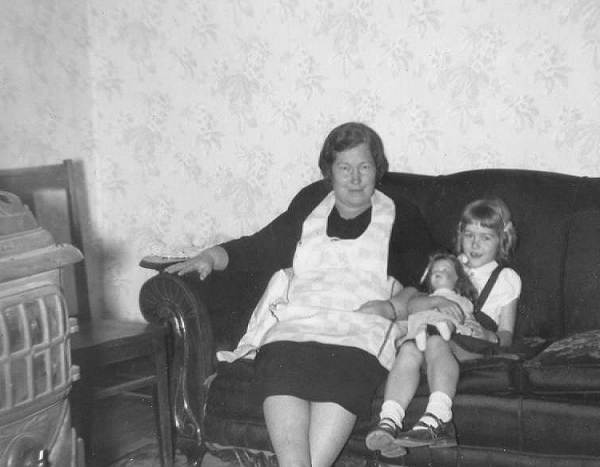
08 Eleanor and Catherine Hendley
She and her brother Ralph had a happy life on the Highway 17 farm (photos 09 and 10).
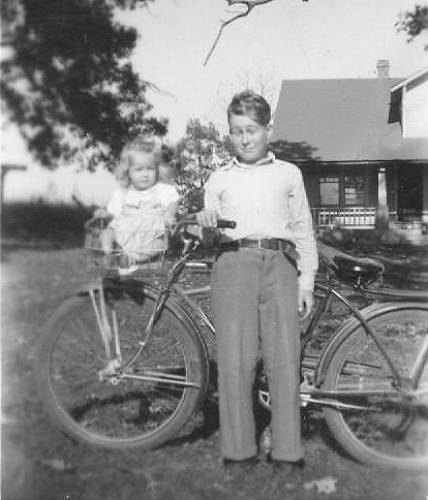
09 Ralph Hendley and sister Catherine
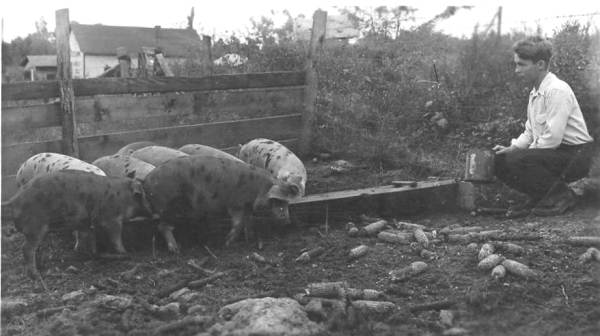
10 Ralph on Farm - Age 16
In later years after his parents passed away, Ralph Hendley inherited the family farm (photo 11).

11 Ralph Hendley
He is well known locally for the many years he has taken a truck south to bring a load of spring peaches to Miller County for sale at his feed store next to his home (photo 12).
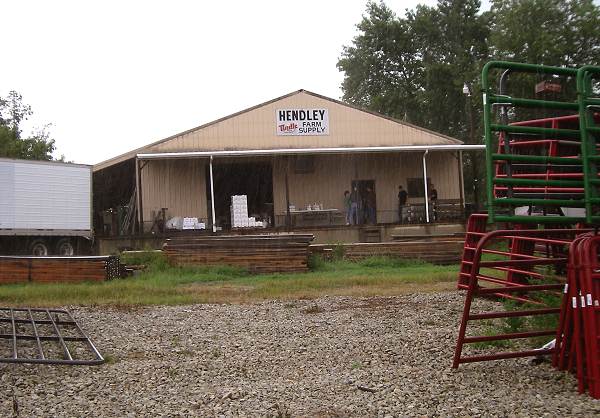
12 Hendley Farm Supply
You can read more about Ralph and his peach truck at this previous Progress Notes.
I visited with Ralph not long ago at the home he has lived in for many years on Highway 17, even as a child. Recently, he placed a number of colored stones for a walkway to his front porch which are very colorful (photo 13).

13 Colored Stone Walkway
Ralph is recovering from a number of serious illnesses recently including cancer; however, he is feeling some better now and expects once again this spring to be selling southern grown Missouri peaches out of his feed store on Highway 17 between Tuscumbia and Iberia.
In January of this year I wrote about the death of my Uncle David Eli Bear, son of my grandfather Madison Bear.
Last month, David’s wife Myra Bonnell Bear also passed away. Here is a family photo of the Bear family siblings and spouses taken a couple of years ago before the deaths of my Uncle David and Aunt Myra Bear (photo 14).
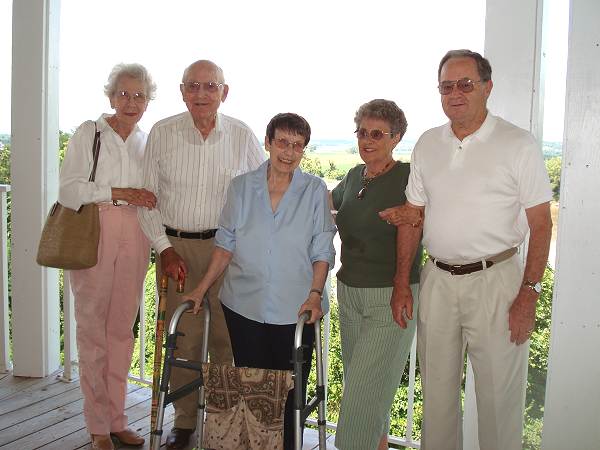
14 Myra and David Bear, Susie Bear Pryor, Bonnie Bear Tyler and husband Bud Tyler
My mother, Susie Bear Pryor, and her sister Bonnie Bear Tyler, are the remaining two children of their parents Madison and Sadie (Abbett) Bear.
The Bear family history, written by David Bear, can be found on our website.
The Bear family migrated from Germany to the state of Pennsylvania in the late 1700’s. Christian Bear, who was a drummer in the Revolutionary War as a teenager, accompanied his son, George Bear and his family when they migrated from the east to Ohio where Christian died and was buried. George and his wife, Elizabeth Vogt Bear, brought ten children with them on the trip (photo 15).
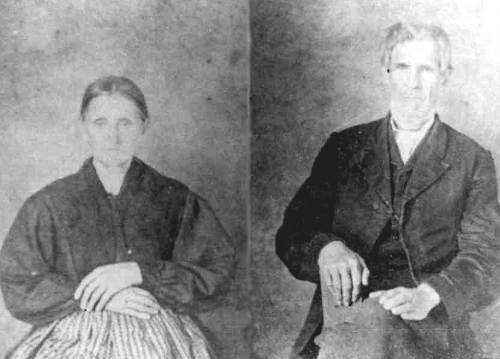
15 George and Elizabeth Bear
After burying Christian in Ohio the family migrated to Miller County arriving in 1857 where the family members settled land in Osage Township on Highway 52 near Dog Creek. The home farm still remains in the Bear family. You can read more about the individual family members at the website above.
Here is a map of the location of the Bear family properties in 1905 produced by Marie Bear Stillwell, great granddaughter of George Bear (photo 15a):
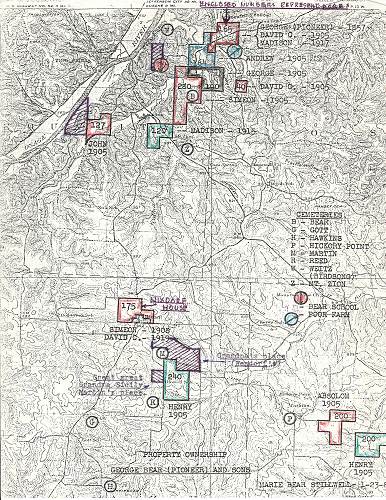
15a Bear Family Properties - 1905
Click image for larger view
One of the major historical evidences remaining of the Bear family can be found on the old courthouse south entrance where the name of George’s son, David Christian Bear, is engraved on the cornerstone on the west side of the door. David Christian Bear was Presiding Judge of the county court when the old stone courthouse was constructed in 1910 (photos 16 and 17).
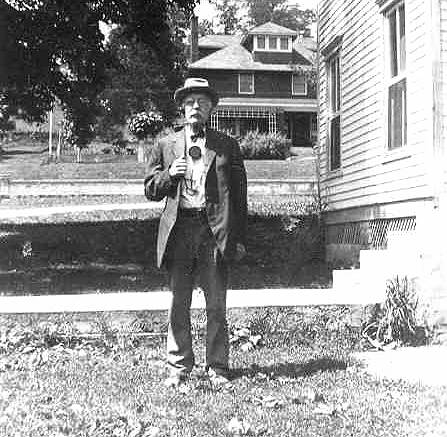
16 David Christian Bear
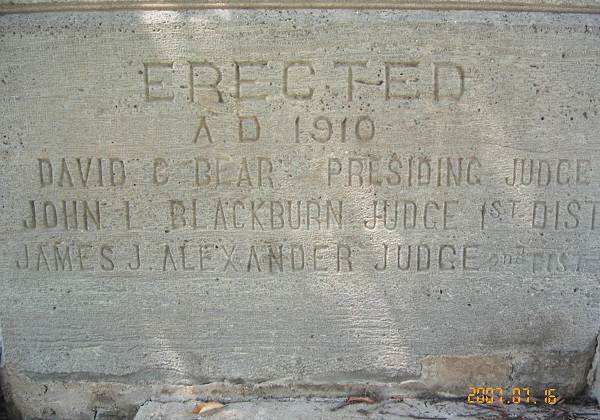
17 Cornerstone Courthouse County Officers
With the death of Myra and David Bear, their children wanted to donate to our museum a number of the Bear family heirlooms. So this week I am going to feature some of the historical items brought to Miller County by the Bear family.
The most important possession of the family was an old German Bible which has been in the family as long as anyone can remember. The Bible was carried by Christian Bear from Pennsylvania to Ohio where he passed away and then was brought to Miller County by Christian’s son, George Bear. I had known about the Bible all my life. When I was a child my grandfather Madison cared for it. Unfortunately, the flood of 1943 caused water damage but with the attention of a restoration consultant some of the damage was repaired. According to Goodspeed’s 1889 History of Miller County where the Bear family history can be found, the Bible was purchased at a sale by Christian Bear in Pennsylvania. This Bible is now on display in our museum (photo 18).
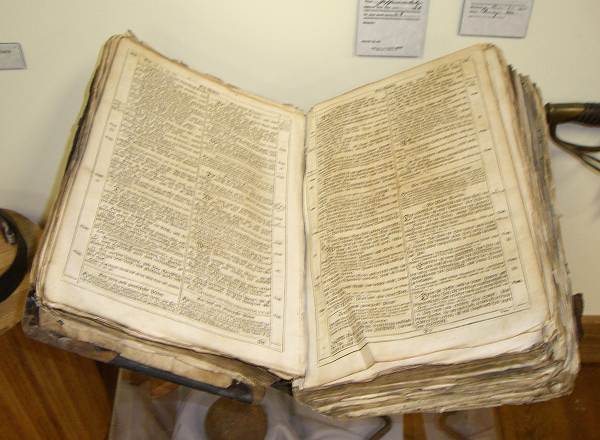
18 Bear German Bible
Here is a photo of Sandra Bear Shelton, great great granddaughter of George Bear, standing beside the old family Bible (photo 19):
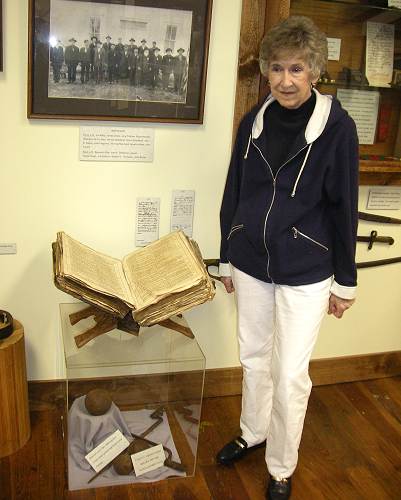
19 Sandra Bear Shelton
Another interesting heirloom of long ago was a hand made doll accompanied by hand made doll furniture which was stored in a hand made wooden case (photo 20).
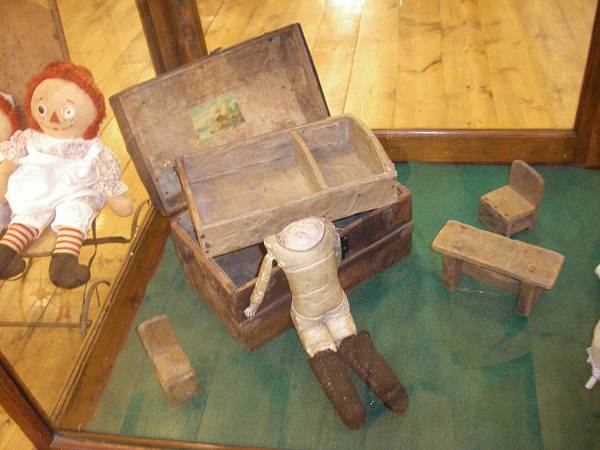
20 Hand Made Doll, Furniture and Chest
Although you can see in the photo the wooden miniature furniture, the box also contained small chairs delicately hand made of wire.
The most historically interesting Bear family exhibit, which had been given to the museum earlier, was a collection of old photos of the George Bear family including his six sons who fought in the Civil War for the North. This display is protected in a glass case (photo 21).
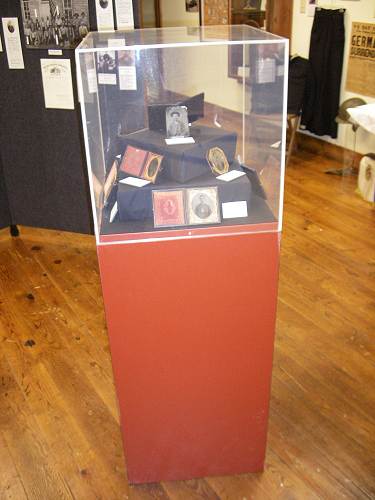
21 Bear Family and Six Civil War Brothers
The Abbett family of Miller County had settled near where the Bear family located in Osage Township. In fact, Madison Bear, grandson of George Bear, married Sadie Abbett who was a great granddaughter of John Abbett (photo 22).
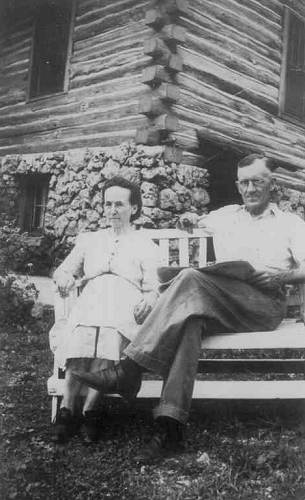
22 Sadie Abbett Bear and Madison Bear
Some of the land acquired by the Bear family had belonged to John Abbett. John was one of the original settlers in the area and had a land grant document issued by the U.S. Government ensuring his legal possession of the land he settled. This document was acquired by the Bear family when the John Abbett property was acquired. Some readers may not have seen one of these documents. Here is a scan of the title page (photo 23):

23 Land Patent
Click image for larger view
The next part of the document had to be scanned in two sections since it was so wide. I pieced together the sections, which you can see here (photo 24):
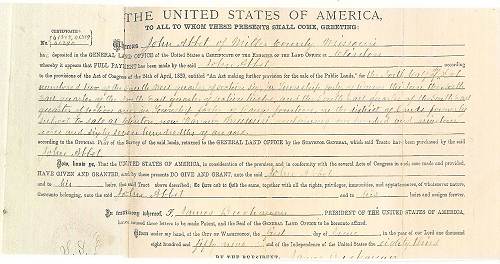
24 John Abbett Land Grant
Click image for larger view
The family also had a similar land grant document registered with the U.S. government by Sayles Brown who was the original owner of property acquired later by the Bear family. Here is that land grant document (photo 25):
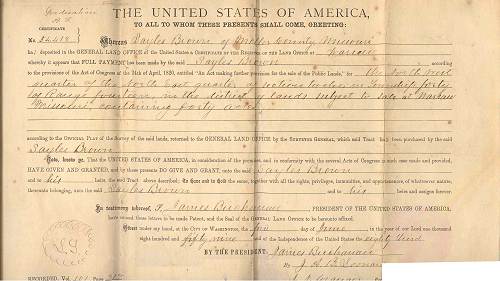
25 Land Patent by Sayles Brown
Click image for larger view
These documents have been donated to the museum also.
I want to thank the David Eli Bear family for entrusting our museum with these very interesting possessions and photos of the George Bear family, one of Miller County’s earlier migrants from the East.
The history of the basis on which the land grant or land patents system was devised is described in the old History of Missouri written by Howard Conard. I would advise saving the reading of this narrative until bedtime because it is a true soporific. However, I doubt I will ever have occasion again to present it and it does have some application to the subject of the Land Grant system:
Land Surveys
History of Missouri
Howard Conard (photo 27)
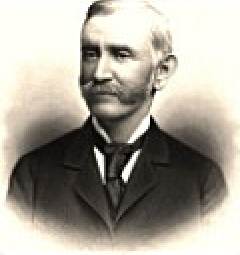
27 Howard Louis Conard
The lands of Missouri, with the exception of the comparatively small amount which had been disposed of by Spanish land grants prior to the cession of 1803, belonged originally to the United States Government, by which it was granted to purchasers by letters patent, and it was customary to trace titles back to these patents, except where the chain of title has been broken by adverse possession under the statute of limitations or by some other tenure recognized by law. The land in Missouri was originally surveyed and marked out by United States surveyors under the public land system of the government, and the methods of identification observed in these original surveys by townships, sections and quarter sections prevails to the present day. In making the original surveys, an east and west line, called a base line, was established running through an initial point, and also a north and south line drawn through the same point and called the principal meridian. On this principal meridian at intervals of twenty four miles other east and west lines are drawn, called standard parallels or correction lines; and at similar intervals along the base line, north and south lines are run. This arrangement divides the land into twenty four mile tracts, which, on account of the converging of the meridianal lines, are slightly narrower at the north than at the south side. These twenty four mile tracts are divided into smaller tracts six miles square, called townships, the townships into sections, and the sections into quarters. A township contains thirty six square miles of land, a section, one square mile, or 640 acres, a quarter section 160 acres, and a quarter of a quarter 40 acres. A north and south row or tier of townships is called a range, and these ranges are numbered east and west of the principal meridian, and the townships are numbered north and south of the base line. The thirty six sections in a township are numbered also, beginning with the northeast one, and going west to the northwest corner, and then going back on the next row of sections from west to east, so that the northeast section is No. 1, the northwest section is No. 6, and the one next south of No. 6 is No. 7; and the section in the southwest corner of the township would be described in a deed as Section 31, township 4 N., Range 15 west of the principal meridian. The 160 acre tract in the southwest corner of the section 31 would be called the S. W. quarter of Section 31; and the 40 acre tract in the southwest corner of that section would be described as the S. W. quarter of the S. W. quarter of Section 31.
Recently, I just happened upon an old newspaper clipping which had no date but revealed that Homer Clay Wright, former President of the Anchor Milling Company and native of Tuscumbia, now deceased, held the Miller County record for time of duty serving on a Grand Jury (photos 28, 29 and 30).

28 Homer Clay Wright
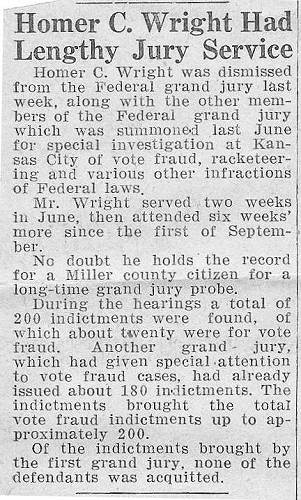
29 Homer Wright Jury Service Article
Click image for larger view
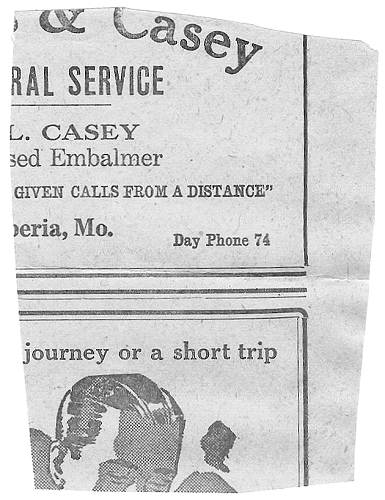
30 Back of Jury Service Article
Click image for larger view
However, what makes this distinction more interesting is that Homer had to serve on a Grand Jury in Kansas City. In fact, according to the clipping Homer served a total of eight weeks, and six weeks were consecutive suggesting he had to stay in the city all that time. The clipping does not give the time frame of Homer’s service on the Grand Jury; however, the back of the clipping has an advertisement for an embalmer with one of the names being Casey. The other name is not on the torn clipping. I did some research and found that Adams and Casey had a store which burned in the Iberia fire of 1939 after which they started a funeral home in the building. This information was found in a previous Progress Notes which discussed the 1939 Iberia Fire.
Therefore, Homer Clay was serving on the jury sometime after 1939. The clipping does not tell us much about the details of what precipitated such a long session for a Grand Jury. However, the years after 1939 were when the Tom Pendergast regime in Kansas City was falling apart and many of those involved were tried and sent to prison. I suspect that Homer Clay served on one of the Grand Juries involved with the Pendergast trials. Here is a narrative from Wikipedia which tells more.
Tom Pendergast
Pendergast's downfall is widely believed to have occurred after a falling out with Lloyd C. Stark. Pendergast had endorsed Stark (famed for developing the Golden Delicious variety of apples and heir to Stark Brothers Nursery-the oldest in America and largest in the world) for governor in 1936. Pendergast was out of the country during the election and his followers were even more obvious and corrupt than usual in Stark's successful election. With Mafia-related shootings, election violence and other events (routinely overlooked previously, although at somewhat lower levels) Treasury Secretary Henry Morgenthau went after Mafia boss Charles Corolla and Pendergast as part of his crackdown on corruption and organized crime. Although Pendergast had loyally mustered out (and manipulated) the vote for Roosevelt and other Democrats Morgenthau directed his subordinates to 'let the chips fall where they may'. With investigations looming, Stark turned against Pendergast, prompting federal investigations and the pulling of federal funds from Pendergast's control.
After Pendergast was convicted of income tax evasion, Stark sought to unseat Harry Truman in the 1940 U.S. Senate election. It was a very bitter campaign that made both men lifelong enemies. Truman was re-elected after U.S. Attorney Maurice Milligan, who had prosecuted Pendergast, also entered the race, causing Milligan and Stark to split the anti-Pendergast vote.
In 1939 Pendergast was arraigned for failing to pay taxes on a bribe received to pay off gambling debts. After serving 15 months in prison at the nearby United States Penitentiary, Leavenworth, he lived quietly at his home, 5650 Ward Parkway, until his death in 1945.
In 1945, Vice President Truman shocked many when, a few days after being sworn in and a few weeks before Truman succeeded Franklin D. Roosevelt as President, he attended the Pendergast funeral. Truman was reportedly the only elected official who attended the funeral. Truman brushed aside the criticism, saying simply, "He was always my friend and I have always been his." 1908 Main is listed on the Kansas City Register of Historic Places although not on the National Register of Historic Places.
I haven’t learned much more about the Grand Jury in K.C. because Homer Clay Wright now is gone and many of those who might have remembered are also. However, it certainly seems a correct interpretation to me at this point that the Jury was related to the Pendergast scandal because of the time frame, the reasons given by the clipping for the Grand Jury, and the information that the Grand Jury was in session for such a long time.
We were honored recently by the visit of Dr. Lyle Hensley to our museum (photo 32).
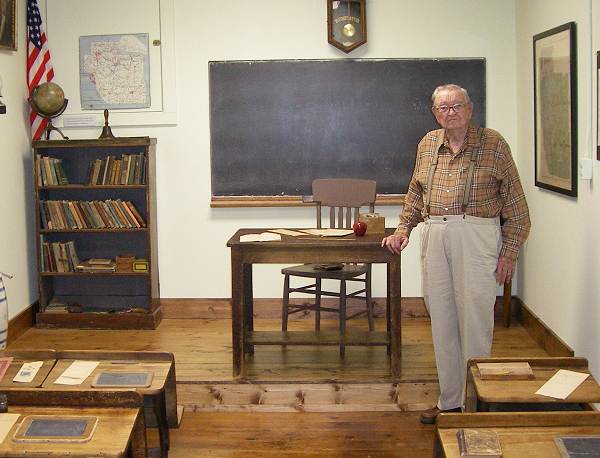
32 Dr. Lyle Hensley in Museum School Room
Dr. Hensley is well known for his very successful leadership of the Eldon and School of the Osage schools over nearly forty years. He was superintendent for Eldon schools from 1959 to 1987 and superintendent of the School of the Osage for ten years until 1997. Dr. Hensley originally was from north Missouri. He was awarded his Doctorate of Education at the University of Missouri. Prior to that he served in the armed forces in WWII as well as Korea. While in Miller County he was able to convince the State of Missouri to place the North Shore of the Lake in the Eldon School district, saved Union Electric taxes for the school district rather than dispersed into the state general funds, helped create the area vocational school at Eldon and was one of the organizers of the county library. After taking the position of superintendent at the School of the Osage he was a principle force in establishing a new school building and auditorium.
Dr. Hensley reports that he was very fortunate to have the support and wise counsel the citizens who served on the school boards as well as the support of the local communities when he was superintendent. Since his retirement more than ten years ago he has lived in Springfield but soon will be moving to Kansas City.
We were honored that Dr. Hensley has decided to donate to our museum library all his personal records and photographs having to do with his long career as superintendent at the Eldon and School of the Osage schools (photo 32a).

32a Dr. Lyle Hensley with Donated Records for Museum Library
Dr. Hensley's records were compulsively kept throughout his entire career and are of very significant historical importance. He was one of the sentinel educators to realize the need for reform and change during the years he served helping to convince the Missouri State legislature to pass important legislation necessary for improvement of our school systems.
Dr. Hensley probably was the most important superintendent at Eldon since the first superintendent, Thomas Everett Vaughan, who was instrumental in getting the first Eldon High School built in 1915 (photos 33 and 34).
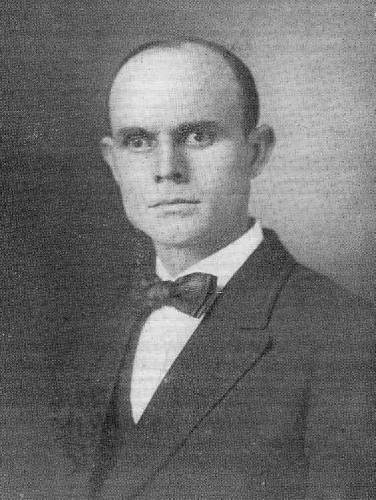
33 T.E. Vaughan

34 Eldon High School Built 1914-1915
You can read about Superintendent Vaughan at these previous Progress Notes:
History of T.E. Vaughan at Eldon
Early biographical history of T.E. Vaughan in Tuscumbia
I enjoyed talking with Dr. Hensley; he spent about two hours with us and demonstrated an almost photographic memory of the details of his experiences at the Eldon and School of the Osage schools.
At our Historical Society members’ meeting last April 10 the highlight of the day was the retirement award ceremony in honor of our noted historian, Peggy Hake, who recently has moved to Kansas City (photo 35).
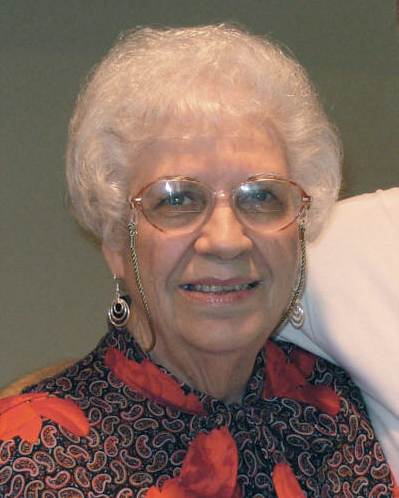
35 Peggy Hake
Of all the historical works I consult when researching material for this webpage, I never fail to check Peggy’s “Windows of the Past” page on our website. She has written quantitatively more than any other Miller County historian. At the meeting I read a summary of her accomplishments which is on our website:
Peggy Smith Hake was born in Miller County, near Iberia, at the end of the Great Depression of the mid 1930s. She was born on a farm in southwest Richwoods Township on land that had been homesteaded by her great, great grandparents, John Levi and Nancy (Keeth) Whittle who came to Miller County from Edmonson County, Kentucky in the mid 19th century. Her ancestral roots are deeply embedded in the land and the history of Miller County. Peggy is the daughter of G. Oliver Smith and Verlie A. (Wyrick), both natives of Miller County. She is a graduate of Iberia High School and spent 12 years in the Iberia school system. For several years she lived in Kansas City and reared her children there. While in Kansas City, she was employed with Indian Springs State Bank of Kansas City, Kansas where she advanced to associate vice president. In 1979, she moved back to her home area near Iberia and spent some time in politics, serving as the county's first woman county judge and commissioner.
Historical and genealogical research began near mid-life for Peggy. In 1975, her grandfather, Henry Franklin Smith, a native of Miller County, died at the age of 92 years and with his passing came an interest of her ancestry. Realizing she had let her best source of information pass on, she began her search of her heritage through the means of personal research in old records that were found in dusty files at courthouses, archives, libraries, and museums. Microfilm was scanned for hours in the National Archives branch office in Kansas City; old newspapers, crumbling with age, were read from cover to cover and most importantly, she took trips to the counties in Kentucky, Tennessee, and Virginia where her ancestors once lived. Records were made available to her and the information acquired put 'the icing on the cake' for her plans to permanently record the history of her ancestral families. In 1990, she made a very interesting trip over the old Oregon Trail re-tracing the route that her ancestors used to resettle in America's Northwest in the state of Oregon. On a beautiful mountainside in the Willamette Valley of western Oregon, she located the graves of her great, great, great grandparents (the Bilyeu family) who had ventured west in the early 1850s.
She has written 3 books pertaining to Miller County history including: "IBERIA ACADEMY AND THE TOWN, ITS HISTORY in 1988"; "PIONEER FAMILIES OF MILLER COUNTY, MISSOURI: Journey to the Past @1990"; and "THEY LEFT A LEGACY: Historical Stories of Miller County, Missouri @1992". For many years she has written a genealogical column for "The Miller County Autogram-Sentinel" newspaper called WINDOW TO THE PAST. For 18 years Peggy edited and published a newsletter of Miller County history called "Seeking 'n Searching Ancestors" with members from all over continental America as well as Hawaii and Alaska. As time progressed, her historical articles have been placed on a website on the internet to be shared by other researchers interested in Miller County's history.
Most of her historical writings also have been placed on the Miller County Museum website.
Until recently she was an active member in the Miller County Historical Society having been an original charter member and original secretary. Also, in previous years she has been a board member of the Miller County Senior Citizens Services Board; member of Iberia VFW Ladies Auxiliary #6167; Iberia American Legion Auxiliary; Iberia Community Club; St. Anthony Sunshine Gals Club; St. Anthony Senior Citizens Club; the Crazy Horse Memorial Foundation of South Dakota; and several historical/genealogical societies across America.
About a year ago due to reasons of deteriorating health, Peggy moved to Kansas City to live with her daughter.
She is the mother of 4 children (Kathy of Independence, MO, Kerry of Pleasant Hill, Kelly of Jefferson City, and Kirk of Iberia); 9 grandchildren; 11 great grandchildren; 4 stepchildren (Bill of Eldon, Becky of Rolla, Donald of St. Elizabeth, & David of Arkansas); 3 step-grandchildren and 4 step great-grandchildren.
After reading to our members the above personal and professional history of Peggy, we presented her with a pink 24 karat gold tipped rose as a gift of appreciation from the society (photo 36).
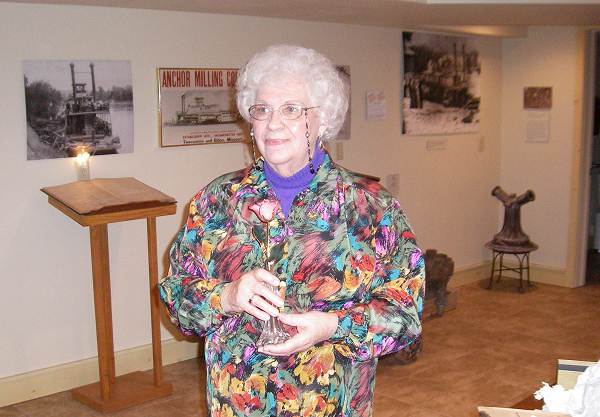
36 Peggy Hake with Gold Tipped Rose
In addition, an engraved plaque honoring her was presented, which will be placed in the museum of (photo 37).
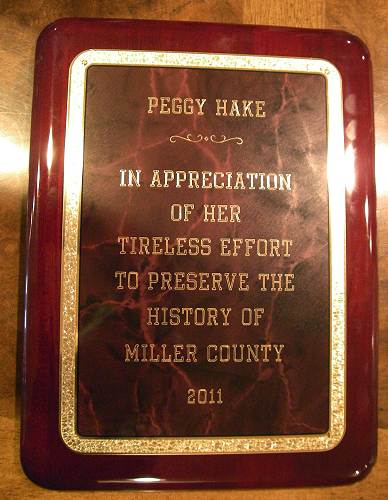
37 Engraved Plaque
Many of her family and friends attended the honorary event for Peggy and they posed with her for this photo (photo 38):
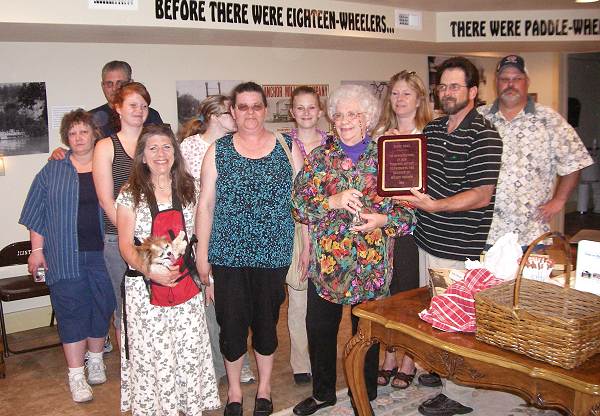
38 Peggy with Friends and Family
Recently, we received a large number of old photographs of the Sherman N. Wolfe family of Eldon (photo 39).

39 Sherman Wolfe
Sherman originally was from Eldon although most of his life later was lived in Flint, Michigan. Many of the photographs do not include the people’s names; therefore, we have them on display in our museum and invite visitors who might have known some of the Wolfe family members to help us identify them (photo 40).
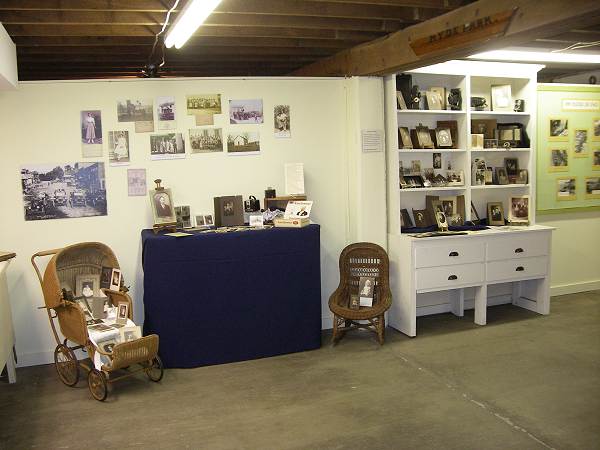
40 Wolfe Photos
Here is a short biography of Sherman taken from his obituary:
Sherman N. Wolfe, of Marion Hall, of Flint, age 95, died Friday, January 16, 1998 at the Greenery in Howell, Michigan. Mr. Wolfe was born in Eldon, Missouri on March 16, 1902, the son of Pearl (Smith) and Edward Wolfe. Sherman worked for Rickenbacker Motors in Detroit, Michigan from 1922 to 1925. He also worked for Buick (GM) from 1925 to 1948. In 1948, Mr. Wolf went to work for Ellis Trucking Company (A.B.F.) and worked for them until his retirement in 1969 as an over the road driver. Sherman spent 18 winters in Casablanca following his retirement. He enjoyed flying and was a licensed pilot. He leaves several long time friends in the Flint area besides cousins and friends in Eldon, Missouri where he will be returned for burial. There will be no visitation at the funeral home.
Allen Funeral Home
Davison, Michigan
Here is a shorter obituary from the Jefferson City News and Tribune:
Obituary: Jefferson City News Tribune, Sunday, January 18, 1998
Sherman N. Wolfe, 95, Davison, Mich., died Friday in Howell, Mich. He was born March 16, 1902, in Eldon, a son of Edward and Pearl Smith Wolfe. He had worked as a truck driver and was a licensed pilot.
Graveside services will be at 11 a.m. Tuesday in Eldon City Cemetery.
Don E. Renken will officiate. Visitation will be from 10-10:45 a.m. Tuesday at Phillips Funeral Home, Eldon.
This coming Saturday, May 14, we open our museum for the coming summer season. We will be serving refreshments and cookies between ten a.m. and four p.m. Entertainment will be provided by Joe Jeffries and his well known and liked group of musicians. Come and see us if you are in the area. Our museum has had many new or revised displays placed since last year under the direction of museum director Nancy Thompson and her staff.
That’s all for this week.
 Joe Pryor
Previous article links are in a dropdown menu at the top of all of the pages.
|

